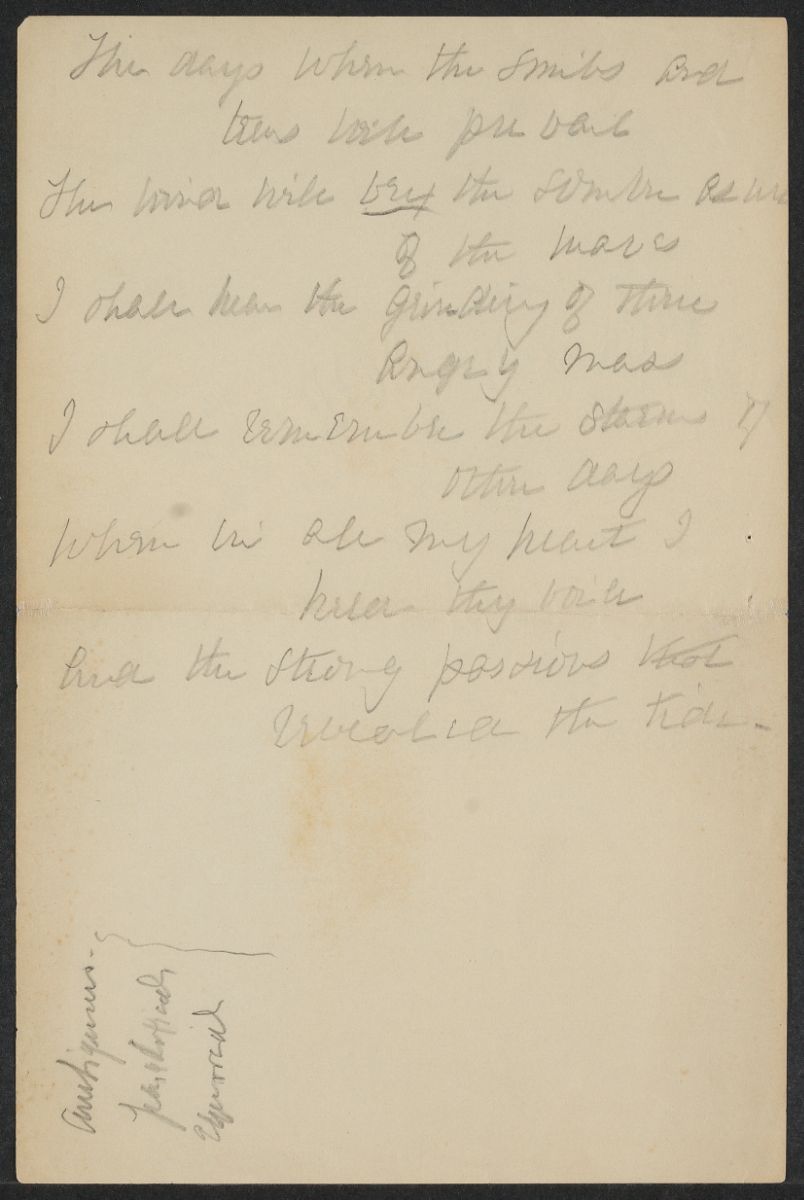<< Return to Poems
The days when the smiles over tears will prevail
< transcription >
H bMS Am 1118.95, Box 9
Handwriting like Ward letters of early 1890’s. Pencil, on single leaf folded in half. These words are written sideways, near bottom of the page: "ambiguous" "paradoxical" "equivocal." More is on verso.
In the elegiac tradition, but the loss to which it alludes is uncertain. A more exact dating will aid the speculation. The speaker’s relationship with the deceased is emotionally complex and more characteristic of an adult attachment, lamenting as it does an historical partnership of sorts-- "When in all my heart I held thy will," -- perhaps Emily or Austin.
A lyric stichic in six lines; it appears to be a hybrid of what Susan called Emily’s "swift poetic rapture" (see "Obituary for Miss Emily Dickinson of Amherst")--her condensed form-- and the more traditional sonnet. Though less than half the traditional sonnet length, the poem has a sonnet philosophy--it is meditative, scenic, musical. There are similarities to the Shakespearean sonnet; the alternating rhyme, iambic pentameter and two concluding lines that could be read as an anti-couplet (unrhymed). If these two lines are not a couplet, they break a scheme of a ms. which appears to be at least a second draft or copy, as there is no evidence of revision within the body and may have been folded for enclosure.) This particular formal combination is so rare for Susan’s later poems that it must be read as a conscious departure, one which may be due in part to the elegiac lament at its core.
Because of its abbreviated form, the poem has almost no printed contemporary analogs. Besides Emily’s stichics, the most likely model for the poem is Wyatt’s "songs," eight-line stichic adaptations of the Italian canto, in ottava rima, rhyming abababcc. Perhaps not surprisingly, Wyatt, whose poems were collected and widely printed in the nineteenth century, is credited with importing the canto which is itself the formal ancestor of the English sonnet.
Even the content of the poem, its manner of address and tone are less resonant with nineteenth century printed poetry and more suggestive of Emily’s. The speaker’s honesty and authority is conveyed in language that echoes Emily’s in its acuity, as in "I shall hear the grinding of their angry mass" which recalls Emily’s famous "I felt a funeral in my brain /... A Service like a drum;" (J 280; c.1861). The reserve and tonal etiquette of other poems is renounced here in favor of the "electric spark" of "revelation," as Susan herself describes Emily’s own directness and economy. Unlike many poems of the nineteenth century, this work appears to own the passion it describes without apology.
Also resonant with Emily’s corpus, Susan’s extended ocean imagery reads like a history of Emily’s ocean/sea /river conceits which in some manifestation or another are always convey power. In poems of the late 1850’s and early 1860’s, Emily associates the sea and it rhythms with the sensual, and arguably even the erotic. In later poems, the ocean/ sea becomes a metaphor for the ideal grave and the mystery of the unfathomable afterlife.
Susan’s dismissal of typographic practice here (there is no end-stop punctuation excepting the concluding Emily-like dash) further supports the theory that her compositional practices, like Emily’s, are closely tied to the medium of transmission and its anticipated audience (see "Irony", "What offering have I [can I bring Thee Lord]", "Valentine’s Day", and "The robin’s choose to-day" for specific discussion of these practices.




